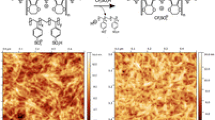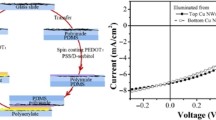Abstract
This article summarizes current applications and the future potential of highly conductive poly(3, 4-ethylenedioxythiophene) (PEDOT). The main focus of the article is a water dispersed complex of PEDOT with poly(styrenesulfonic acid) (PSS) as the counter-ion. The availability of PEDOTPSS as an ink allows many facile ways of solution processing. The basic chemical and physical properties of the PEDOTPSS complex are discussed to show the fundamentals that allow for the use of PEDOT in transparent conductive applications. Due to the increase in conductivity and transparency of the PEDOT:PSS complex in recent years, this versatile material now has reached the requirements for current devices such as displays, touch screens, and solar cells, and offers an alternative to inorganic transparent conductive oxides. Further advantages of this polymer are the ductility, use in low-cost production processes such as printing, safe handling, and availability on a large scale.




Similar content being viewed by others
References
C.K. Chiang, C.R. Fincher, Jr., Y.W. Park, A.J. Heeger, H. Shirakawa, E.J. Louis, S.C. Gau, A.G. MacDiarmid, Phys. Rev. Lett. 39, 109 (1977).
H. Shirakawa, E.J. Louis, A.G. MacDiarmid, C.K. Chiang, A.J. Heeger, J. Chem. Soc, Chem. Commun. 578 (1977).
A.J. Epstein, Handbook of Conducting Polymers, 3rd Edition (CRC Press Boca Raton, FL, 2007).
E.M. Conwell, Handbook of Organic Conductive Molecules and Polymers (Wiley, Chichester, UK, 1997).
A.J. Heeger, J. Phys. Chem. B 105, 8475 (2001).
F. Jonas, G. Heywang, DE 3813589 (Bayer AG), April 22, 1988.
A. Elschner, S. Kirchmeyer, W. Lövenich, U. Merker, K. Reuter, PEDOT: Principles and Applications of an Intrinsically Conductive Polymer (CRC Press, Boca Raton, FL, 2011), pp. 126.
L. Groenendaal, F.Jonas, D. Freitag, H. Pielartzik, J.R. Reynolds, Adv. Mater 12, 481 (2000).
S. Kirchmeyer, K. Reuter, J. Mater. Chem. 15, 2077 (2005).
Y. Kudoh, K. Akami, Y. Matsuya, Synth. Met. 98, 65 (1998).
N. Karibyants, H. Dautzenberg, H. Cölfen, Marcomolecules 30, 7803 (1997).
J. Ouyang, Q. Xu, C.-W. Chu, Y. Yang, G. Li, J. Shinar, Polymer 45, 8443 (2004).
Y. Xia, J. Ouyang, Macromolecules 42, 4141 (2002).
S. Timpanaro, M. Kemerink, F.J. Touwslager, M.M. De Kok, S. Schrader Chem. Phys. Lett. 394, 339 (2004).
H.W. Heuer, R. Wehrmann, S. Kirchmeyer, Adv. Funct. Mater 12, 89 (2002).
K. Fehse, K. Walzer, K. Leo, W. Lövenich, A. Elschner, Adv. Mater. 19, 441 (2007).
Y. Galagan, J.E.J.M. Rubingh, R. Andriessen, C.C. Fan, P.W.M. Blom, S.C. Veenstra, J.M. Kroon, Sol. Energy Mater. Sol. Cells 95, 1339 (2011).
Author information
Authors and Affiliations
Corresponding author
Rights and permissions
About this article
Cite this article
Elschner, A., Lövenich, W. Solution-deposited PEDOT for transparent conductive applications. MRS Bulletin 36, 794–798 (2011). https://doi.org/10.1557/mrs.2011.232
Published:
Issue Date:
DOI: https://doi.org/10.1557/mrs.2011.232




